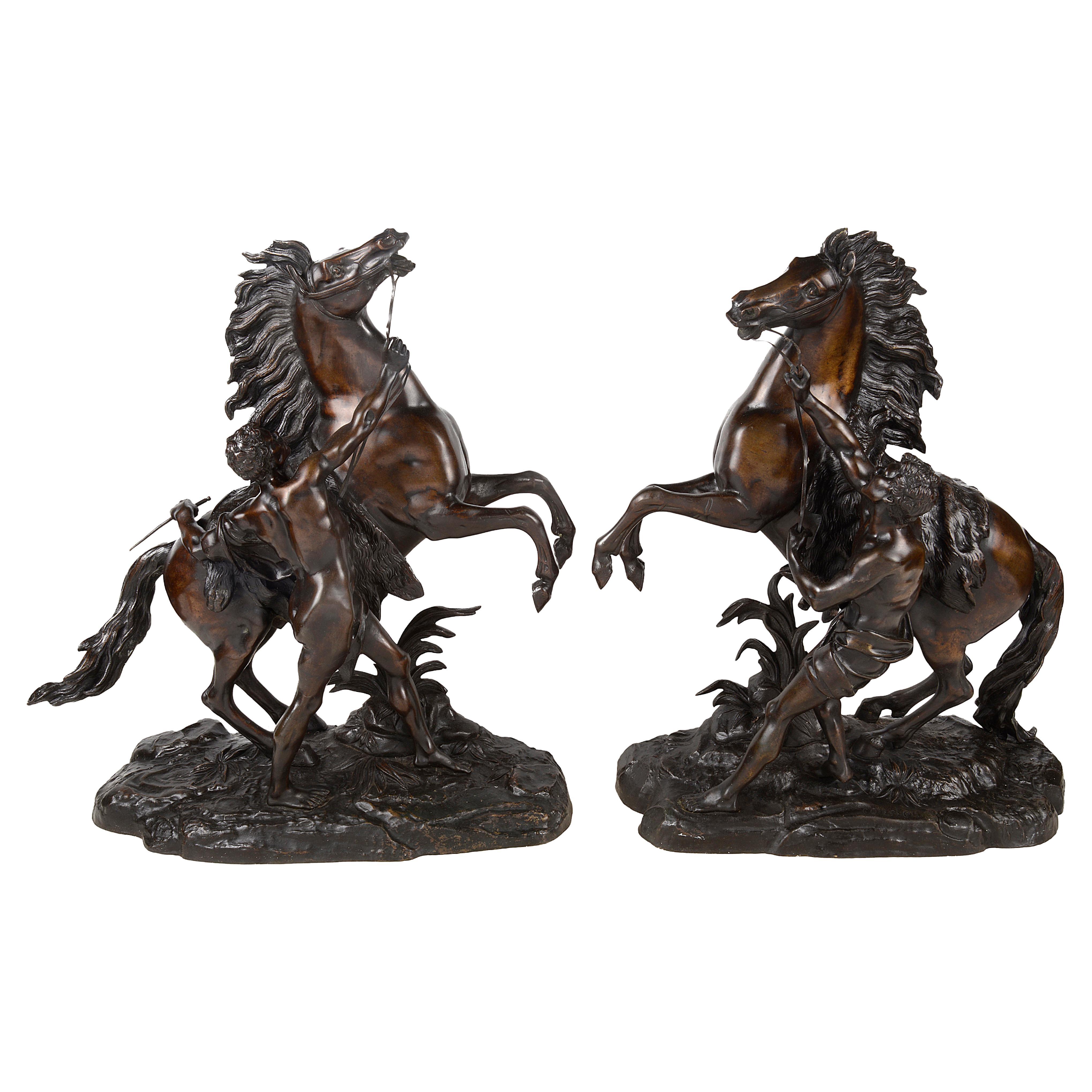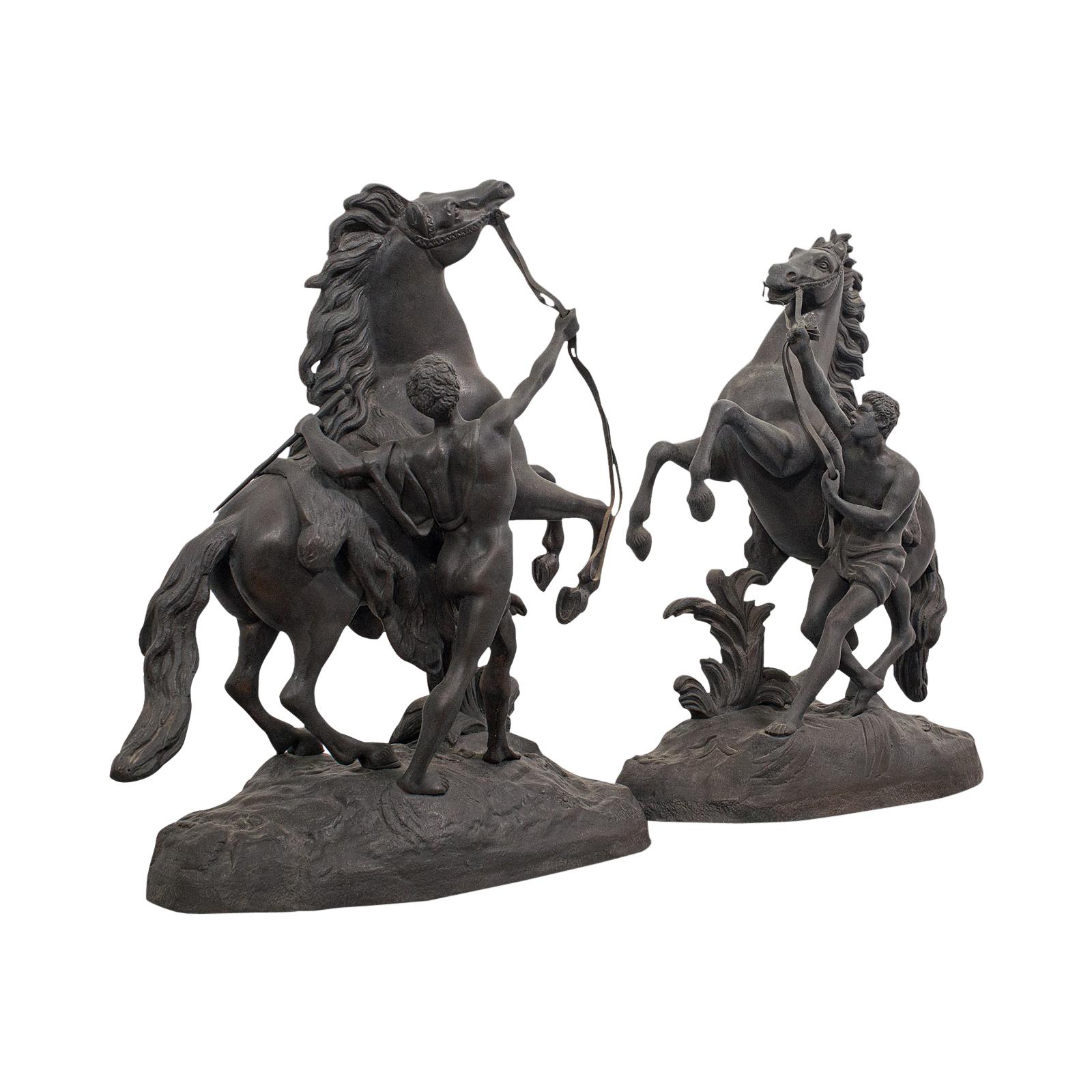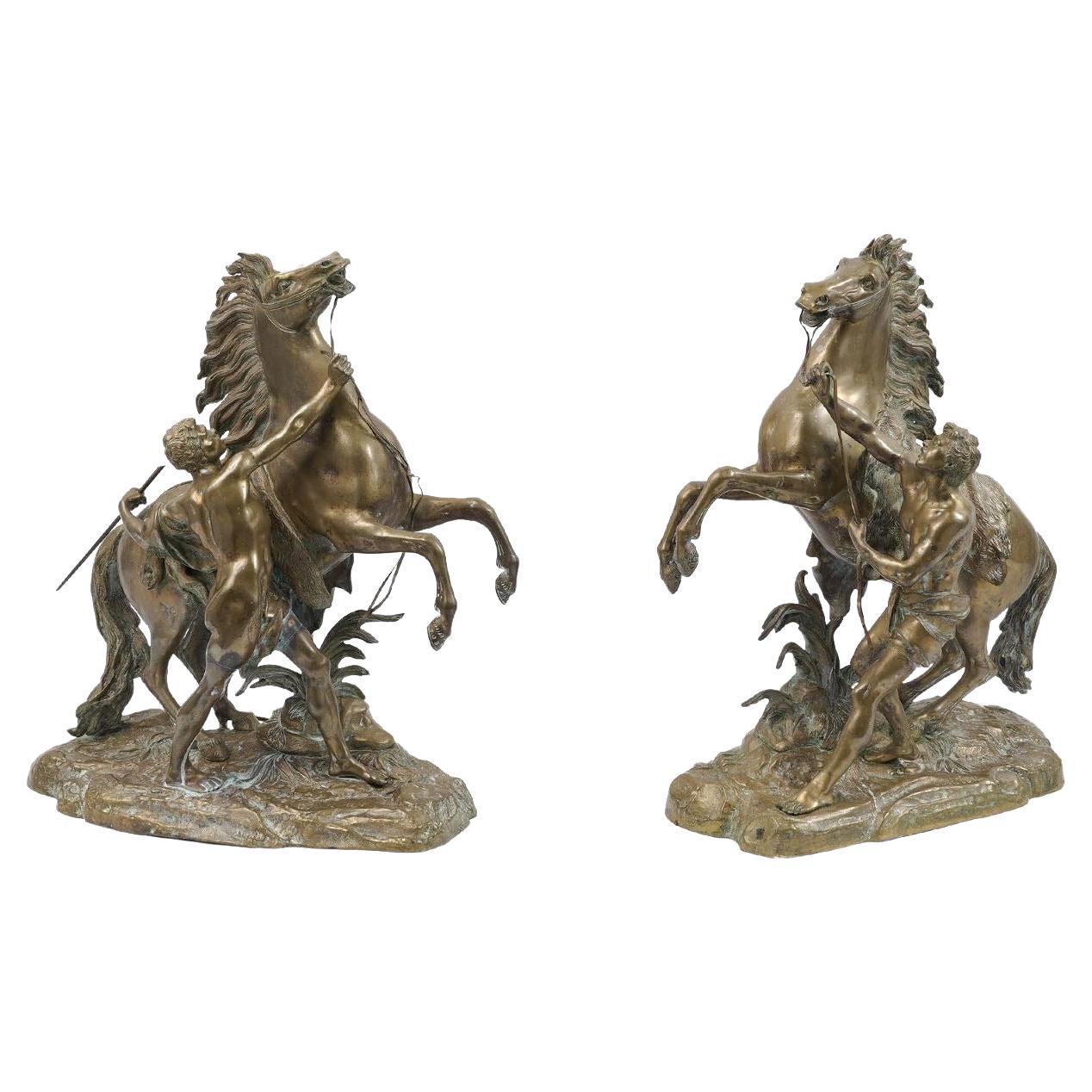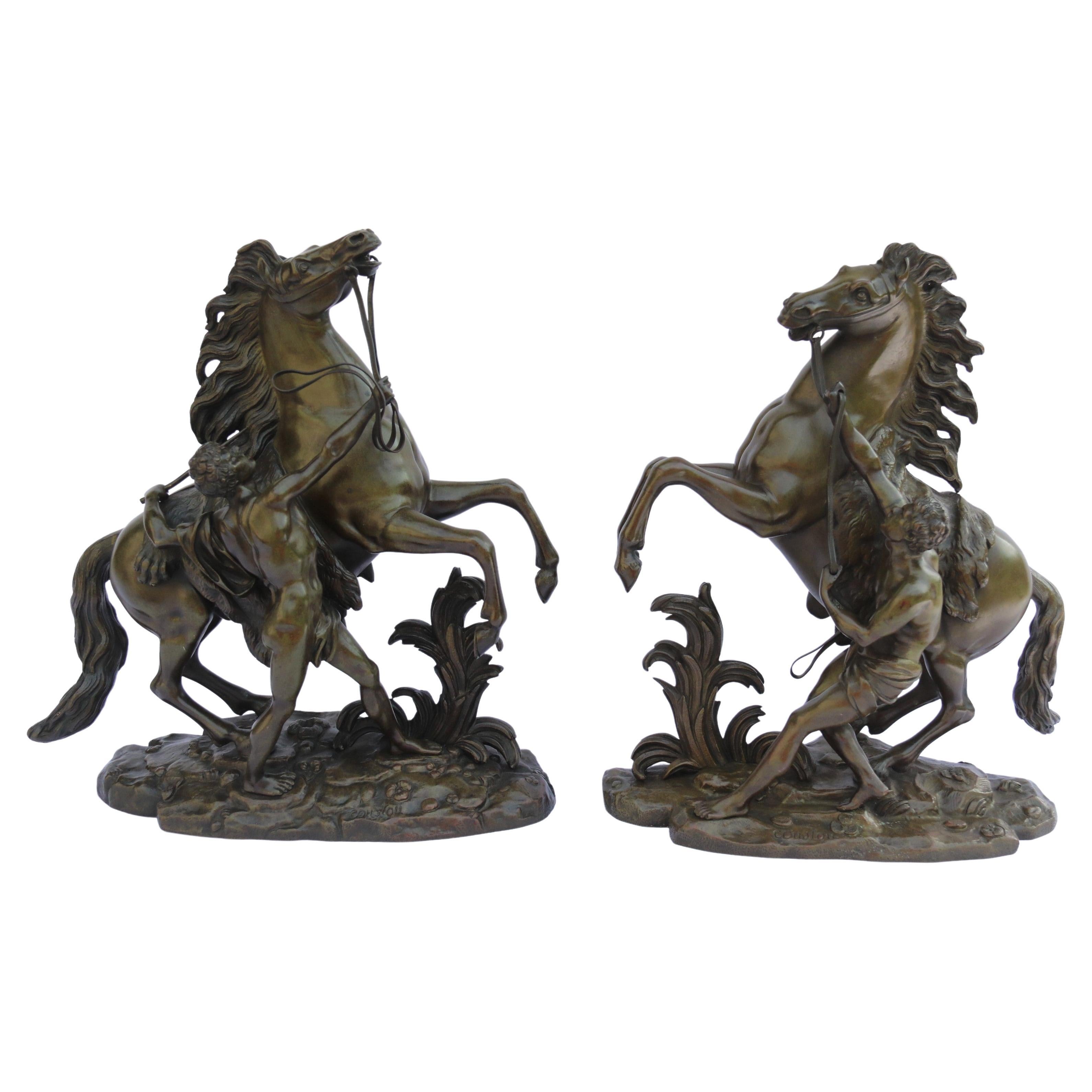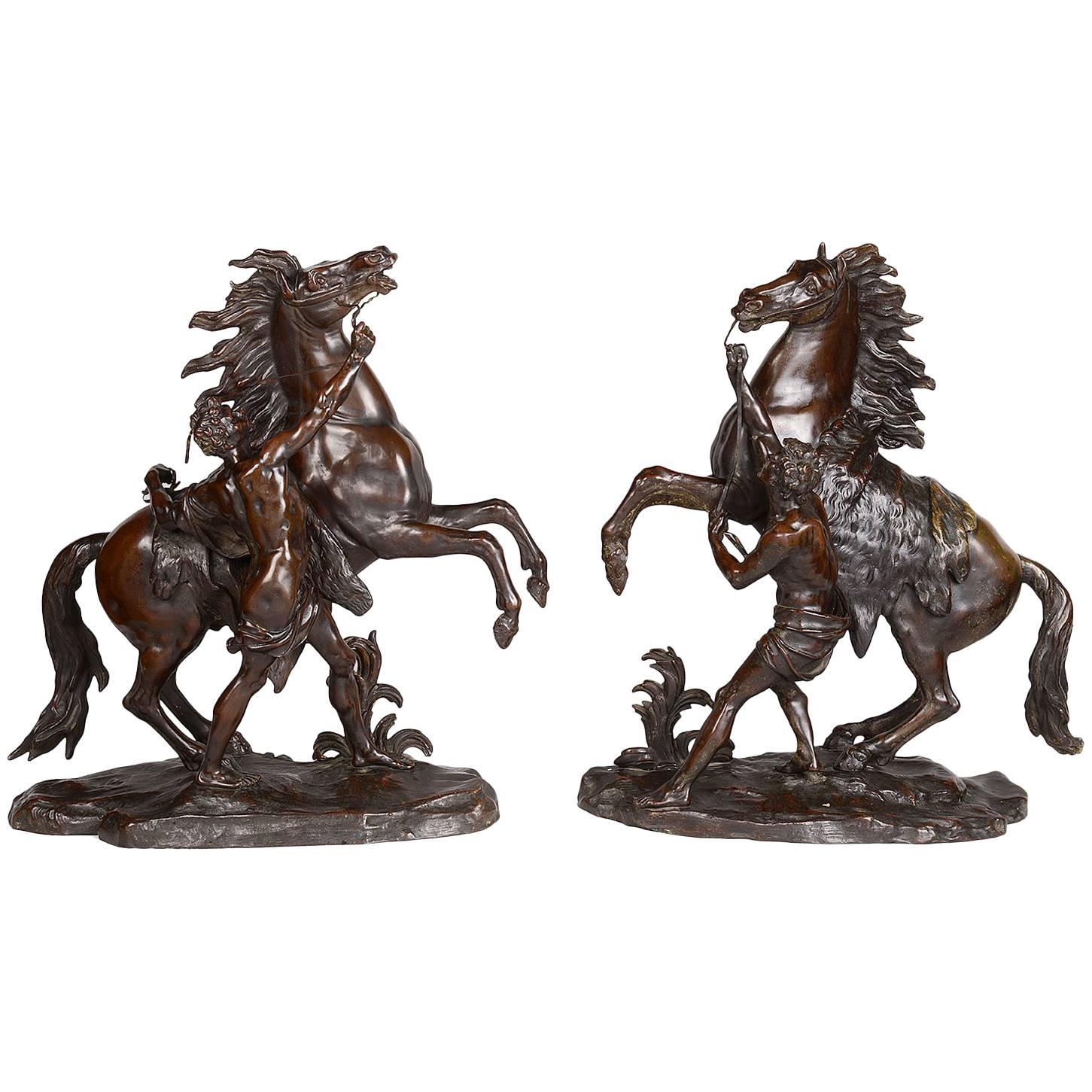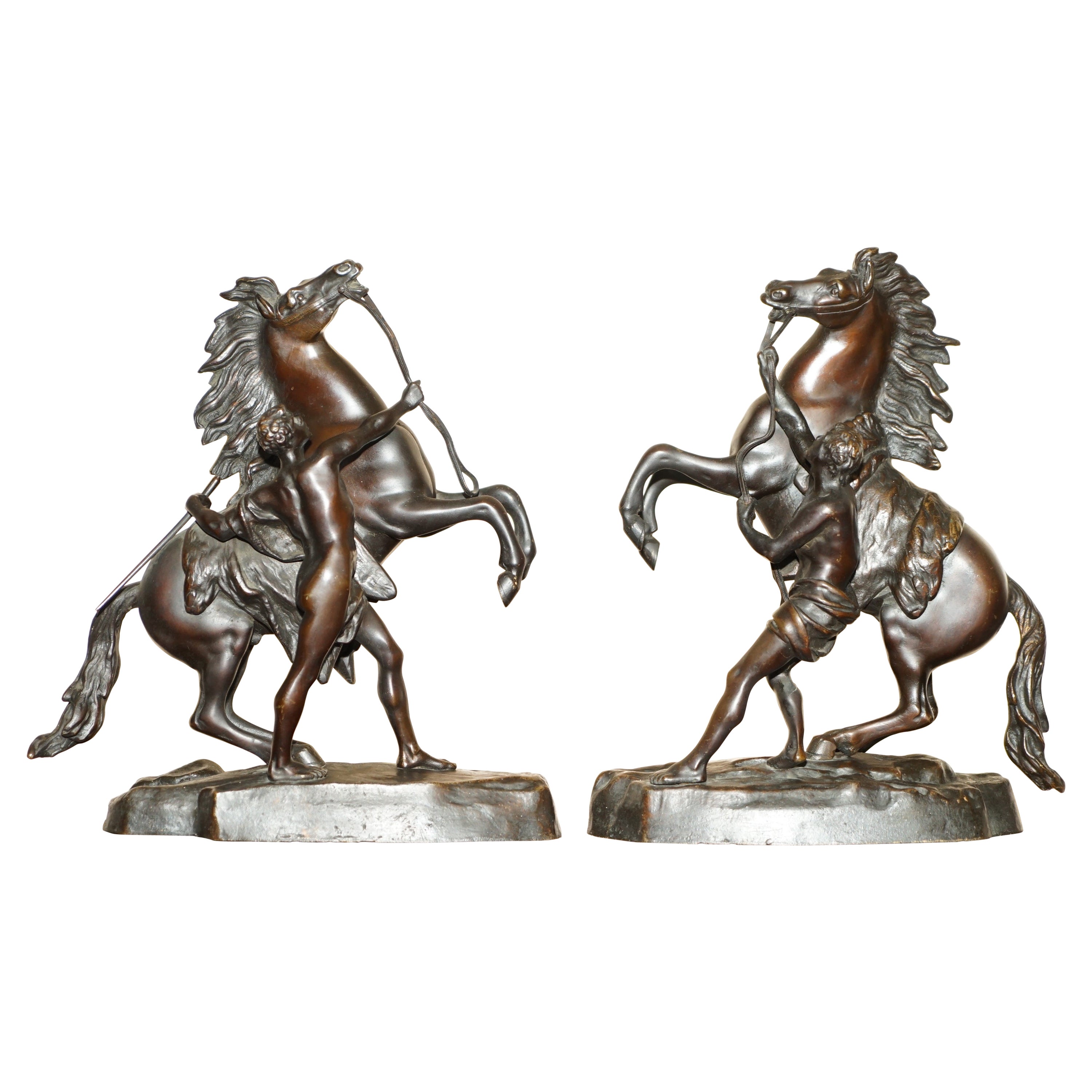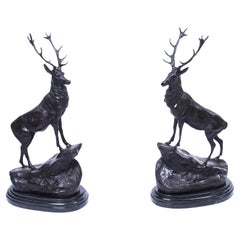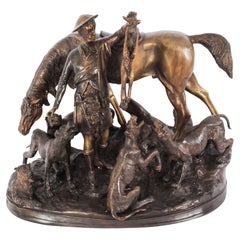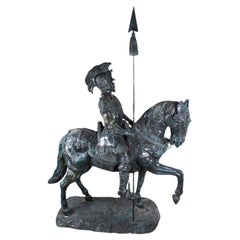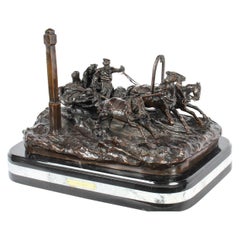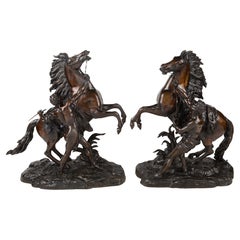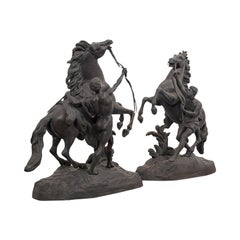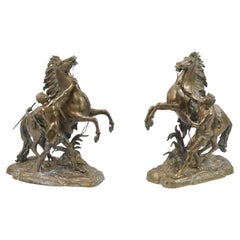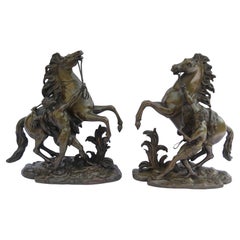Items Similar to Antique Pair of French Bronze Marly Horses Sculptures by Cousteau 19th Century
Video Loading
Want more images or videos?
Request additional images or videos from the seller
1 of 21
Antique Pair of French Bronze Marly Horses Sculptures by Cousteau 19th Century
$4,060.43per set
£2,950per set
€3,457.88per set
CA$5,543.25per set
A$6,166.64per set
CHF 3,232.63per set
MX$75,354.89per set
NOK 41,163.54per set
SEK 38,749.77per set
DKK 25,811.73per set
Shipping
Retrieving quote...The 1stDibs Promise:
Authenticity Guarantee,
Money-Back Guarantee,
24-Hour Cancellation
About the Item
This is a fine antique pair of French Grand Tour patinated-bronze sculptures of the Marly Horses, Circa 1850 in date and signed to one base.
The original Marly Horses were commissioned by Louis XV of France, sculpted in Carrara marble, showing two rearing horses with their grooms, by Guillaume Coustou, and made in 1743 and completed in 1745. They now sit in the courtyard of the Richelieu wing of the Louvre Museum.
Both statues have a lovely dark brown patination which is shown in all its glory, and these high-quality hot cast solid bronze statues were produced using the traditional "lost wax" process, otherwise known as the "cire perdue" method.
The attention to detail here is remarkable and this truly beautiful pair of bronze statues are sure to receive the maximum amount of attention wherever placed.
Provenance:
Purchased from Duke's 25th January 2002, lot 812, purchase price £4080 GBP.
Condition:
In excellent condition with no dings, dents or signs of repair. Please see photos for confirmation.
Dimensions in cm:
Height 61 x Width 56 x Depth 30 & Weight 20.4 kg
Height 59 x Width 49 x Depth 24 & Weight 23.55 kg
Dimensions in inches:
Height 2 foot x Width 1 foot, 10 inches x Depth 1 foot & Weight 45.0 lbs
Height 1 foot, 11 inches x Width 1 foot, 7 inches x Depth 9 inches & Weight 51.9 lbs
The Marly Horses are two 1743–1745 Carrara marble sculpted groups by Guillaume Coustou, showing two rearing horses with their groom. They were commissioned by Louis XV of France for the trough at the entrance to the grounds of his Chateau de Marly. Coustou's last works, they were intended to replace two other sculpted groups, Mercury on Pegasus and Pegasus, Renown of Horses, both by Antoine Coysevox, which had been removed to the Tuileries Gardens in 1719.
Louis XV chose the modellos in 1743 and the full-size sculptures were completed in only two years, being installed at Marly in 1745. They proved highly successful in reproduction, particularly on a smaller scale, and prefigured Théodore Géricault and other Romantic artists' obsession with equestrian subjects. The Marly horses were later also used as the central motif of the monochrome 819-line RTF/ORTF test card which was used on TF1 from 1953 until 1983.
The originals were moved to the place de la Concorde in Paris in 1794 and Louis-Denis Caillouette (1790–1868) restored them in 1840. In 1984 it was concluded that the annual military parades on 14 July were damaging the sculptures and they were replaced by marble copies produced by Michel Bourbon in the studio of a subsidiary of Bouygues. The latter also gained the right to an extra copy, which was placed in Bouygues's social building. The original sculptures were moved to a former courtyard in the Richelieu wing of the Louvre Museum, which was renamed the 'cour Marly' in their honour, whilst Bourbon's two main copies were moved to the originals' first site near the trough at Marly, with work overseen by the architect Serge Macel.
Our reference: A3576
- Dimensions:Height: 24.02 in (61 cm)Width: 22.05 in (56 cm)Depth: 11.82 in (30 cm)
- Sold As:Set of 2
- Style:Grand Tour (In the Style Of)
- Materials and Techniques:
- Place of Origin:
- Period:
- Date of Manufacture:circa 1850
- Condition:
- Seller Location:London, GB
- Reference Number:Seller: A35761stDibs: LU950636846232
About the Seller
5.0
Platinum Seller
Premium sellers with a 4.7+ rating and 24-hour response times
Established in 1983
1stDibs seller since 2012
1,374 sales on 1stDibs
Typical response time: <1 hour
Associations
LAPADA - The Association of Arts & Antiques Dealers
- ShippingRetrieving quote...Shipping from: London, United Kingdom
- Return Policy
Authenticity Guarantee
In the unlikely event there’s an issue with an item’s authenticity, contact us within 1 year for a full refund. DetailsMoney-Back Guarantee
If your item is not as described, is damaged in transit, or does not arrive, contact us within 7 days for a full refund. Details24-Hour Cancellation
You have a 24-hour grace period in which to reconsider your purchase, with no questions asked.Vetted Professional Sellers
Our world-class sellers must adhere to strict standards for service and quality, maintaining the integrity of our listings.Price-Match Guarantee
If you find that a seller listed the same item for a lower price elsewhere, we’ll match it.Trusted Global Delivery
Our best-in-class carrier network provides specialized shipping options worldwide, including custom delivery.More From This Seller
View AllVintage Pair of Large Bronze Stag Statuettes After Moigniez, 20th Centurry
Located in London, GB
This is a handsome pair of bronze stags, bearing the replica signature of well known French sculptor Jules Moigniez, from the last quarter of the 20th century.
The stags are made ...
Category
Vintage 1980s Animal Sculptures
Materials
Marble, Bronze
Vintage Bronze Group Hunter & Hounds with Fox Late 20th Century
Located in London, GB
This is a superb vintage patinated bronze group of a hunter holding a fox over his hounds, dating from the late 20th Century.
The bronze comprises a central Scottish hunter...
Category
1990s English Figurative Sculptures
Materials
Bronze
Vintage Life Size Bronze Roman Armoured Officer on Horseback 20th Century
Located in London, GB
This is a beautiful ornately decorated Vintage life size bronze sculpture of a heavily armored Roman Cavalry officer on horseback, riding triumphantly into battle, dating from the l...
Category
Late 20th Century Figurative Sculptures
Materials
Bronze
Antique Russian Bronze Sculpture After Vasily Grachev 20th Century
Located in London, GB
This is a truly magnificent antique Russian bronze sculpture after Vasily Grachev (1831-1905) titled "The Milepost" and dating from the early 20...
Category
Antique Early 1900s Russian Figurative Sculptures
Materials
Bronze
Vintage Pair Life-Size Bronze Stags Deer Statues 20th Century
Located in London, GB
This is an absolutely stunning pair of enormous life-size bronze stags, dating from the last quarter of the 20th century.
They stand listening carefully with perked up ears and impo...
Category
20th Century Animal Sculptures
Materials
Bronze
Vintage Magnificent Large Pair of Cast Bronze Medici Lions Late 20th Century
Located in London, GB
This is a historically interesting bronze sculpture of a pair of lions after the original Medici Lions placed at the Villa Medici, Rome. This pair dating from the second half of the 20th Century.
The lions are sitting on their haunches with one front paw on a sphere, and they are facing right and left with their tails on opposite sides. They feature beautifully toned muscles and sleek detailed manes, which signifies their masculinity and reflects their health.
This high-quality hot cast solid bronze pair was produced using the traditional "lost wax" process, otherwise known as the "cire perdue" method.
It is a majestic pair which will look lovely equally at home indoors or outdoors.
Condition:
In excellent condition, please see photos for confirmation.
Dimensions in cm:
Height 96 x Width 43 x Depth 95
Dimensions in inches:
Height 3 foot, 2 inches x Width 1 foot, 5 inches x Depth 3 feet, 1 inch
Lost Wax Method
sometimes called by the French name of cire perdue or the Latin, cera perduta is the process by which a bronze or brass is cast from an artists sculpture.
In industrial uses, the modern process is called investment casting. An ancient practice, the process today varies from foundry to foundry, but the steps which are usually used in casting small bronze sculptures in a modern bronze foundry are generally quite standardised.
The Medici lions are a pair of marble sculptures of lions, one of which is Roman, dating to the 2nd century AD, and the other a 16th-century pendant; both were by 1598 placed at the Villa Medici, Rome. Since 1789 they have been displayed at the Loggia dei Lanzi in Florence. The sculptures depict standing male lions with a sphere or ball under one paw, looking to the side.
Copies of the Medici lions have been copied and publicly installed in over 30 other locations, and smaller versions made in a variety of media; Medici lion has become the term for the type.
The Albani lion, a similar ancient sculpture, now at the Louvre
A similar Roman lion...
Category
Vintage 1970s Animal Sculptures
Materials
Bronze
You May Also Like
Large Pair of 19th Century Bronze Marly Horses, After Coustou
By Guillaume Coustou
Located in Brighton, Sussex
A very impressive pair of 19th century bronze Marly horse, having a good patina, after Guillaume Coustou the elder 1677-1746.
Category
Antique 19th Century French Animal Sculptures
Materials
Bronze
Collectible Antique Pair of Marly Horses French, Bronze, Equine, Statue, Coustou
Located in Hele, Devon, GB
This is a dashing, collectible antique pair of Marly horses. A French, bronze equine statue in the manner of Guillaume Coustou (1677-1746), dating to the late 19th century, circa 1900.
Excellent representations of the famous Marly horses, on display in the Louvre
Each displaying a desirable aged patina, pleasingly natural finish
Appreciably heavy bronze in very good original condition
Weighing 7.74kg and 7.70kg respectively (approximately 17lb each)
Two horses rear up as their grooms struggle to contain their inherent power
The majesty of each horse resplendent with their sense of dynamism
Defined, muscular haunches beneath detailed horse tack
Further embellished with flowing manes and swishing tails
Each groom with a look of surprise and fear at the ensuing situation
Representative miniature leather reigns unite them with the animal
The originals commissioned by King Louis XV, for the gardens of the Chateau de Marly
Standing upon a detailed base and bearing the signature of the original sculptural artist Coustou
This is a striking and eternally collectible antique pair of Marly horses. Considered a masterpiece of French sculpture, the large marble originals skilfully represented here in quality, heavy bronze. With the originals displayed in the Musee de Louvre...
Category
Antique Late 19th Century French Animal Sculptures
Materials
Bronze
Pair 19th Century French Bronze Marly Horse Sculptures After Coustou
By Guillaume Coustou
Located in New York, NY
Pair of 19th century French bronze marly horse statues after the original models by Guillaume Coustou (1677-1746).
Category
Antique Late 19th Century French Neoclassical Figurative Sculptures
Materials
Marble, Bronze
Large Pair of French 19th Century Bronze Marly Horses After Costou, circa 1870
By Guillame Costou
Located in Central England, GB
This fantastic pair of 19th century finely sculpted, large scale bronze figures are after Guillaume Costou (1677 – 1746. )They each depict a wild prancing horse being restrained by t...
Category
Antique 1870s French Louis Philippe Animal Sculptures
Materials
Bronze
Large Pair of 19th Century Bronze Marly Horses, after Coustou
By Coustou
Located in Brighton, Sussex
A very impressive pair of 19th century bronze Marly horse, having a good patina, after Guillaume Coustou the elder 1677-1746.
Category
Antique 19th Century French Animal Sculptures
Materials
Bronze
Pair of Antique Bronze Guillaume Coustou Marly Horses Statues as Seen the Louvre
By Guillaume Coustou
Located in West Sussex, Pulborough
We are delighted to offer for sale this stunning pair of Guillaume Coustou bronze “Marly Horse” statues as seen in The Louvre Paris
These are a very good looking and nicely executed pair, they are in solid bronze and have been wonderfully sculpted
The original Marly Horses are two 1743–1745 Carrara marble sculpted groups by Guillaume Coustou, showing two rearing horses with their groom. They were commissioned by Louis XV of France for the trough at the entrance to the grounds of his château de Marly.
Coustou's last works, they were intended to replace two other sculpted groups, Mercury on Pegasus and Pegasus, Renown of Horses, both by Antoine Coysevox...
Category
Antique 19th Century French French Provincial Animal Sculptures
Materials
Bronze
More Ways To Browse
Antique French Chateau
Military Horse
Antique Horse Weight
Mercury Scale
Bronze Military Sculpture
Bronze Equestrian Statue
24 Inch Statue
Winged Bronze Statue
Bronze Sculpture Of Mercury
Winged Mercury
19th Century Bronze Equestrian Sculptures
Bronze Pegasus
Marly Horse
Mercury Marble Sculpture
Horse Trough
Grand Tour Marble Foot
Mercury Statues
Bronze Marly Horses
